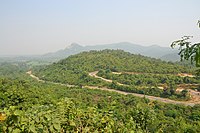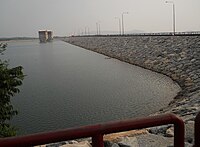Ajodhya Hills
| Ajodhya hills | |
|---|---|
| অযোধ্যা পাহাড় | |
 | |
| Highest point | |
| Peak | Chamtuburu |
| Elevation | 720 m (2,360 ft) |
| Listing | Hills of West Bengal |
| Coordinates | 23°17′12″N 86°06′56″E / 23.28667°N 86.11556°E |
| Geography | |

8km 5miles J H A
R
K H A N D
Chandni Hill △ △
Ajodhya Hills
Chamtuburu △
Subarnarekha River T
Bamni Falls T T
Ajodhya Hill top T X H R
Patardi R R R R R R R R M C
C
C Places in Jhalda subdivision in Purulia district. Key: M: municipality, C: census town, R: rural/ urban centre, H: historical/ religious centre, X: craft centre, T: tourist centre, △: hills Owing to space constraints in the small map, the locations in the larger map on click through may vary slightly. | |
| Parent range | Chhotanagpur Plateau |
Ajodhya Hills (Bengali: অযোধ্যা পাহাড়), is a small plateau with hilly surroundings located in the Purulia district of the state West Bengal, India. It is the easternmost part of the Chhotanagpur Plateau and extended part of Eastern Ghats range. Highest peak of Ajodhya Hills is Chamtuburu (720 m).[1] The nearby populated town area is Bagmundi.
Geography
[edit]Overview
[edit]
It is a popular place for young mountaineers to learn the basic course in rock climbing. There are three routes available to reach Ajodhya Hills. Via Jhalda, via Sirkabad and via Baghmundi. There are two Forest Rest Houses here, one at Ajodhya hill top and the other is at Matha range office. Other accommodation facilities are also available in Ajodhya Hill top and Bagmundi. There are Eco-resorts, 1. Gorgaburu Eco-resort, 2. Palash Bitan Jungle Hut at Murguma 3. Eco-Adventure Resort at Khairabera, 4. Hotel Palash Awashan and Palashbari Restora, Indian-Chinese-Tandoori Restaurant at Ajodhya Hilltop. Gorgaburu with a height of 677 m (2,221 ft),[2][3] Mayuri etc. are some of the peaks of Ajodhya hills range.[4] Chamtuburu 699 m (2,293 ft)[1] is also the highest peak of southern West Bengal.
The area forms the lowest step of the Chota Nagpur Plateau. The general scenario is undulating land with scattered hills. The area around Baghmundi or Ajodhya Hill is an extended plateau.[5]
| Name | Height | Notes |
|---|---|---|
| Chemtaburu | 699 m (2,293 ft) | [1] |
| Gorgaburu | 642 m (2,106 ft) | |
| Chandni Pahar | 620 m (2,030 ft) | |
| Ganjaburu | 602 m (1,975 ft) | |
| Mayur Pahar | 598 m (1,962 ft) | |
| Gojaburu | 585 m (1,919 ft) | |
| Jajahatu | 575 m (1,886 ft) | |
| Pakhi Pahar | 480 m (1,570 ft) | |
| Mathaburu | 478 m (1,568 ft) | |
| Kuhuburu | 468 m (1,535 ft) |
History
[edit]
During Mughal times the area was a part of Bengal Subah. Later on after defeat of Mughals, the area became a part of Manbhum district under the British Raj. After the independence the area became a part of Bihar state. After states were reorganised in mid fifties the area came under West Bengal.
Famous Deulghata Jain temples (11th cent AD) lies about 15 K.M. north of Ajodhya Hills. Charida the village of Chhau mask makers, lies just south of the southern boundary of the hills. It is said that the mask making for famous ‘Chhau’ dance started under the auspices of king Madan Mohan Singh Deo of Banghmundi.
According to Hindu mythology, Rama and Sita had come to Ajodhya Hills and stayed during their exile. Sita was thirsty and Ram pierced an arrow through the Earth's soil crust and through that water gushed out. Sita quenched her thirst. The place is known as Sita-kunda. During the full moon day in Baisakh every year Santhal, Bhumij and Munda tribals of nearby areas come and join in the game of hunting wild animals, called Disum Sendra.[4][6]
Natural History & Heritage
[edit]Rocks that make up Ajodhya hills belong to a group of rocks called Chhotanagpur Granite Gneiss Complex. Investigations have revealed that they formed more than a billion years ago in Mesoproterozoic era.[7] Since then the area underwent multiple phases of tectonic movements, and witnessed metamorphic and magmatic episodes, thus forming varieties of rocks that we see today. Prolonged erosion through ages sculpted the area and formed its admirable river valleys, residual hills, lakes, springs and waterfalls that make the area a major ecotourism hot spot. There are at least 37 locations where tourists can see and admire these rocks and landforms.[2] They are called geosites which are known for their distinct aesthetic appeal as well as for being archives that record the history of Earth. They are popular among geotourists.
Apart from being geodiverse, the area is also biodiverse. Many species of mammals, amphibians, insects etc can be spotted in the dry, deciduous forests of the region. One such species is the Madras treeshrew which is small mammal, not common in West Bengal.[citation needed] Among the trees, Sal, Palash, Kusum, Mohua, Kend, and various bamboos are commonly observed.
Distance from Kolkata
[edit]- Balarampur (268m above Mean Sea Level): 319.7 km (198.7 mi)
- Matha (260m above MSL): 335.8 km (208.7 mi)
- Sirkabad (302m above MSL): 317.5 km (197.3 mi)
- Ajodhya Hill Top (575m above MSL): 289.9 km (180.1 mi) (Via Sirkabad)
- Jhalda (304m above MSL): 306.1 km (190.2 mi)
Places to Visit based on Balarampur-Bagmundi Route
[edit]- Ajodhya Hill Top: About 5 Hotels, Resorts and Lodges. 42 km from Balarampur Rly. Station via Matha. 24 km from Matha Forest Range Office. 18 km from Bagmundi.
- Matha Forest Rest House: 18 km from Balarampur Rly. Station. 10 km from Bagmundi.
- Bagmundi: 28 km from Balarampur Rly. Station.
- Turga Dam and Turga Falls: 30 km from Balarampur Rly. Station. 2 km from Bagmundi.
- Upper Dam and Lower Dam of Purulia Pumped Storage Hydel Power Project: 36 km from Balarampur Rly. Station. 18 km from Matha. 10 km from Bagmundi.
- Paprakocha Dam, Gorgaburu Eco-Resot: 13 km from Balarampur Rly. Station. 12 km from Matha. 23 km from Bagmundi.
- Gorgaburu Eco-Resot: 13 km from Balarampur Rly. Station. 12 km from Matha. 23 km from Bagmundi.
- Khayrabera Dam and Chamtuburu Hill: 32 km from Balarampur Rly. Station. 14 km from Bagmundi. 24 km from Matha.
- Machkanda Falls: 40 km from Balarampur Rly. Station. 22 km from Bagmundi. 32 km from Matha. (All via Khayrabera)
- Chamtuburu Hill: 32 km from Balarampur Rly. Station. 14 km from Bagmundi. 24 km from Matha.
- Bamni Falls: 40 km from Balarampur Rly. Station. 22 km from Matha. 14 km from Bagmundi.
- Durga Bera: 39 km from Balarampur Rly. Station. 21 km from Matha. 13 km from Bagmundi.
Places to Visit from Ajodhya Hill Top (with distance)
[edit]
- Upper Dam (495m above MSL) and Lower Dam (300m above MSL) of Purulia Pumped Storage Hydel Power Project: 6 km and 9 km on same route
- Durga Bera (572m above MSL): 7 km
- Bamni Falls (434m above MSL): 10 km
- Turga Dam (284m above MSL) and Turga Falls: 18 km
- Khayrabera Dam and Chamtuburu Hill: 21 km (via forest road), 30 km (via Bagmundi)
- Machkanda Falls: 18 km
- Murguma Dam: 20 km
- Matha: 23 km
- Baghmundi (264m above Mean Sea Level ): 16 km
- Charida: 21 km
- Pine Forest: 3 km
- Mayur Pahar (605m above MSL): 2 km
- Balarampur Rly. Station: 39 km
- Sirkabad: 15 km
Distance from Jhalda
[edit]- Murguma (338m above MSL): 16 km (9.9 mi) (Via Begunkodar)
- Khairabera (304m above MSL): 32 km (1.2 mi) (Via Bagmundi)
Development
[edit]Purulia Pumped Storage Project with an installed capacity of 900 MW (4 X 225 MW) has been set up in Ajodhya hills under Baghmundi police station with the loan assistance of Japan Bank for International Cooperation.[8]
Near Ajodhya Hills, there is Turga Dam and the Lake, and the pleasant waterfall formed by the River Bamni. The Turga Dam site is a tourist spot, where the visitors can spend their day.[4]

References
[edit]- ^ a b c "Survey of India". onlinemaps.surveyofindia.gov.in. Retrieved 2024-08-23.
- ^ a b c Ghosh, A.; Mandal, R.; Chakrabarty, P. (2023). "Inclusive Tourism Adopted to Geosites: A Study in the Ajodhya Hills of West Bengal in India". Tourism and Hospitality. 4 (2): 321–335. doi:10.3390/tourhosp4020020.
- ^ "Official Site of Government of India, West-Bengal".
- ^ a b c "Ajodhya Hills". asiarooms.com. Archived from the original on 2008-01-10. Retrieved 2009-04-07.
- ^ Houlton, Sir John, Bihar, the Heart of India, 1949, p. 170, Orient Longmans Ltd.
- ^ Singh, K. S. (2008). People of India: Bihar (2 pts.). Anthropological Survey of India. ISBN 978-81-85579-09-2.
- ^ Misc. Authors (2013). Geology & Mineral Resources of West Bengal (3rd ed.). Kolkata: Geological Survey of India.
- ^ "Purulia Pumped Storage Project". West Bengal State Electricity Board. Retrieved 2019-05-16.
Gallery
[edit]-
Bandhu Bridge, Entrance via Sirkabad
-
Pond at Ajodhya top
-
Pine forest near forest office at hill top
-
Bamni Falls
-
Purulia Pumped storage project
-
Chemtaburu Hill view point
-
Top view from Chemtuburu Hill at 1700 ft
-
Ajodhya Chemtaburu Hill - Khairabera Dam
External links
[edit]- Ajodhya Photographs at TrekEarth











